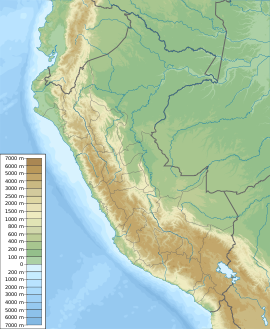You can help expand this article with text translated from the corresponding article in Spanish. (May 2016) Click [show] for important translation instructions.
|
This article needs additional citations for verification. (August 2009) |
Huaca Pucllana or Huaca Juliana[1] (possibly from Quechua wak'a a local shrine to a protector deity, a sacred place, sacred, pukllana game)[2] is a great adobe and clay pyramid located in the Miraflores district of central Lima, Peru, built from seven staggered platforms. It served as an important ceremonial and administrative center for the advancement of the Lima Culture, a society which developed in the Peruvian Central Coast between the years of 200 AD and 700 AD.
 The front of Huaca Pucllana | |
| Alternative name | Huaca Juliana |
|---|---|
| Location | Miraflores, Lima |
| Coordinates | 12°06′40″S 77°02′02″W / 12.11111°S 77.03389°W |
| History | |
| Cultures | Lima, Wari, Yschma |
| Site notes | |
| Website | Museo de Sitio Huaca Pucllana |
With the intended purpose of having the elite clergymen (who politically governed several valleys in the area) express their complete religious power and ability to control the use of all the natural water resources (saltwater and freshwater) of the zone, a Great Pyramid was constructed in the Huaca.
As a whole, the structure is surrounded by a plaza, or central square, that borders the outer limits, and by a large structured wall dividing it into two separate sections. In one section there were benches and evidence of deep pits where offerings of fish and other marine life took place in order to attain the favor of the gods. The other section is an administrative area. This area contains various small clay structures and huts made of adobe–with some walls still standing–whose function seemed to be to act as the courtyards and patios of the enclosure which is over 500 meters in length, 100 in width and 22 in height.
Other remains have been uncovered belonging to the Wari Culture (500 – 1000 AD), which was a direct influence on the Lima Culture society towards the ends of its time period. Of particular note are the remains of the "Señor de los Unkus" (The Lord of the Unkus), which belonged to the first tomb within the ceremonial center to have been discovered completely intact. This tomb holds three separate burial shrouds containing the remains of three adults–two of which have masks–and those of a sacrificed child.
Images
edit-
Recreation ritual offering vessel, Lima culture
-
Huaca Pucllana is located in urban Lima
-
Ceremonial pit
See also
editReferences
edit- ^ Higgins, James (2005). Lima: a cultural history. Oxford [Oxfordshire]: Oxford University Press. p. 18. ISBN 0-19-517891-2.
- ^ Teofilo Laime Ajacopa (2007). Diccionario Bilingüe: Iskay simipi yuyayk’anch: Quechua – Castellano / Castellano – Quechua (PDF). La Paz, Bolivia: futatraw.ourproject.org.
